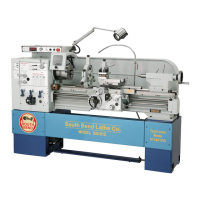What to do if my South bend Lathe does not start?
- SSamuel JacksonNov 21, 2025
If your South bend Lathe doesn't start, several issues could be the cause. First, ensure the emergency stop push-button is disengaged by rotating it clockwise until it pops out. Next, check that the spindle ON/OFF switch is in the ON position. Also, verify that the main power switch and circuit breaker are turned ON. It's also possible a fuse has blown in the machine's electrical box due to thermal overload, so replace the fuse. Make sure that electrical box door, chuck guard, spindle, and brake switches are not engaged and that headstock oil is pumping. Check that the thermal overload relay has tripped; if so, turn the thermal relay cut-out dial to increase working amps and push the reset pin. If these steps don't resolve the issue, there may be a short in the electrical system, a faulty ...

